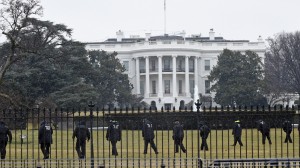
White House gets drone defense wake-up call
The quadcopter drone that crashed onto the White House grounds overnight has highlighted the growing security threat posed by small Unmanned Aerial Vehicles (UAVs), experts warn.
The White House incident comes less than two weeks after a drone flew over the French presidential palace in Paris.
“I do think it’s a wake-up call for the government to start thinking about how it will protect against this type of thing — it’s important for the government and the military in general,” Missy Cummings, associate professor in the Department of Mechanical Engineering and Materials Science at Duke University, told FoxNews.com. “This [White House drone] was harmless, but in the future it might not be.”
The Secret Service said Monday that the drone was a 2-foot-long commercially available “quadcopter.” Brian Leary, a Secret Service spokesman, said an officer posted on the south grounds of the White House complex “heard and observed” the device “flying at a very low altitude” shortly after 3 a.m. ET. The commercially available device was said to pose no threat.
Caroline Baylon, a cybersecurity researcher at the The Royal Institute of International Affairs, Chatham House, in London, told FoxNews.com that drones, thanks to their small size and ability to hover low over the ground, can pose a huge security headache.
“They have opened up this whole area that we haven’t defended against before,” she said. “Most radar can’t deal with drones that fly really low.”
Baylon, who has studied the spate of drone incidents in the French nuclear industry, explained that taking down a drone is no easy task. “You can shoot a drone down, but it requires a certain level of marksmanship,” she said. “It’s easier said than done.”
The researcher told FoxNews.com that technologies being considered to combat UAVs include a new breed of ‘interceptor’ drones.
One interceptor that has attracted plenty of attention is the Rapere drone. The developers behind the technology say Rapere will hover over a target drone and lower a “tangle-line” to disable its rotor blades. “Right now we are flying under the radar for commercial reasons, but all will be revealed in time,” explains the Rapere project website.
“All you have to do is get something in the rotors,” noted Cummings, a former fighter pilot, but warned that it can be hard for an interceptor drone to find the “enemy drone.”
The Rapere drone uses 12 cameras pointing in every direction. The device uses a range-imaging technique called ‘structure from motion’ to reach its target, according to the project website.
The U.S. military is also ramping up its anti-drone efforts. Last year, for example, the Office of Naval Research announced plans to build a laser weapon to shoot down drones.
However, Cummings believes that this type of technology, like the U.S. military’s “Black Dart” anti-drone program, will be more effective at taking down much larger drones. She also noted the risk of collateral damage that laser weapons pose in a densely-populated area.
For secure locations such as the White House, quickly identifying small, low-flying drones will be key, according to Cummings. “They need to figure out how to detect these things,” she said. “Radar doesn’t detect them so you really need some new camera vision technology.”
Wireless technology could also be a crucial weapon in combating the drone threat, enabling authorities to locate UAVs and also identify IP addresses associated with the devices.
Scott Schober, CEO of Metuchen, N.J.-based wireless specialist Berkeley Varitronics Systems told FoxNews.com that his company sells a drone detection tool. “All these commercial drones are using standard open Wi-Fi for video telemetry and control and communication,” he said. “We can pick up an approaching drone that might be a threat, the model number, its altitude and approach speed.”
The company’s Yellowjacket tablet Wi-Fi analyzer also can find the precise location of a drone and its pilot, according to Schober.
A man has claimed responsibility for the drone that crashed onto the White House grounds early Monday, an incident that triggered an immediate lockdown and a Secret Service investigation.
Secret Service spokeswoman Nicole B. Mainor said the individual contacted the agency Monday morning to “self-report” the incident. According to Mainor, “initial indications are that this incident occurred as a result of recreational use of the device.”
A U.S. official told The Associated Press the man said he didn’t mean to fly the drone over the White House; he is said to be cooperating with investigators. The New York Times reported he is a government employee, though he does not work for the White House.
The FAA is referring inquiries about today’s incident to the White House.
The Associated Press contributed to this report.





Leave a Reply